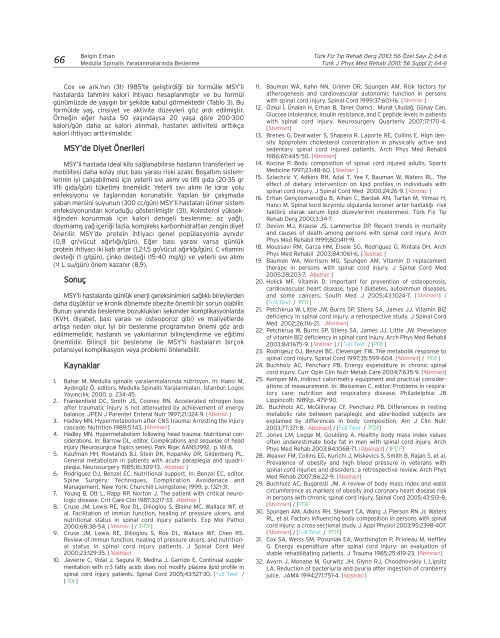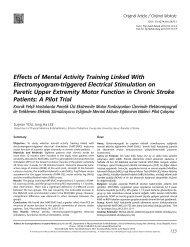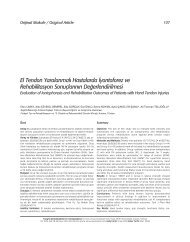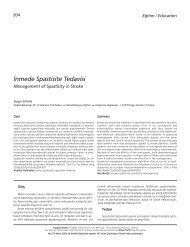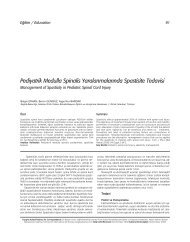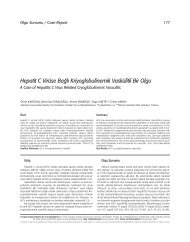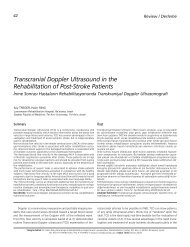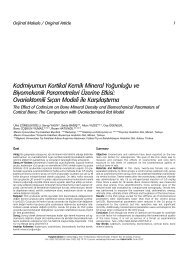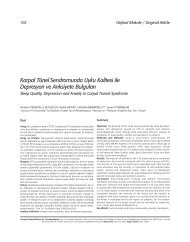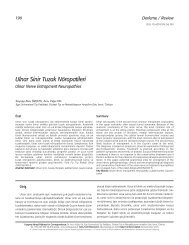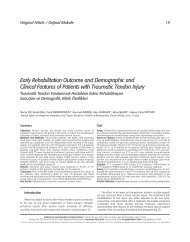Medulla Spinalis Yaralanmal› Hastalarda Beslenme - FTR Dergisi
Medulla Spinalis Yaralanmal› Hastalarda Beslenme - FTR Dergisi
Medulla Spinalis Yaralanmal› Hastalarda Beslenme - FTR Dergisi
You also want an ePaper? Increase the reach of your titles
YUMPU automatically turns print PDFs into web optimized ePapers that Google loves.
66<br />
Cox ve ark.’n›n (31) 1985’te gelifltirdi¤i bir formülle MSY’li<br />
hastalarda tahmini kalori ihtiyac› hesaplanm›flt›r ve bu formül<br />
günümüzde de yayg›n bir flekilde kabul görmektedir (Tablo 3). Bu<br />
formülde yafl, cinsiyet ve aktivite düzeyleri göz ard› edilmifltir.<br />
Örne¤in e¤er hasta 50 yafl›ndaysa 20 yafla göre 200-300<br />
kalori/gün daha az kalori al›nmal›, hastan›n aktivitesi artt›kça<br />
kalori ihtiyac› artt›r›lmal›d›r.<br />
MSY’de Diyet Önerileri<br />
MSY’li hastada ideal kilo sa¤lanabilirse hastan›n transferleri ve<br />
mobilitesi daha kolay olur, bas› yaras› riski azal›r. Boflalt›m sistemlerinin<br />
iyi çal›flabilmesi için yeterli s›v› al›m› ve lifli g›da (20-35 gr<br />
lifli g›da/gün) tüketimi önemlidir. Yeterli s›v› al›m› ile idrar yolu<br />
enfeksiyonu ve tafllar›ndan korunabilir. Yap›lan bir çal›flmada<br />
yaban mersini suyunun (300 cc/gün) MSY’li hastalar› üriner sistem<br />
enfeksiyonundan korudu¤u gösterilmifltir (31). Kolesterol yüksekli¤inden<br />
korunmak için kalori dengeli beslenme; az ya¤l›,<br />
doymam›fl ya¤ içeri¤i fazla, kompleks karbonhidrattan zengin diyet<br />
önerilir. MSY’de protein ihtiyac› genel popülasyonla ayn›d›r<br />
(0,8 gr/vücut a¤›rl›¤›/gün). E¤er bas› yaras› varsa günlük<br />
protein ihtiyac› iki kat› artar (1,2-1,5 gr/vücut a¤›rl›¤›/gün), C vitamini<br />
deste¤i (1 g/gün), çinko deste¤i (15-40 mg/g) ve yeterli s›v› al›m›<br />
(>1 L su/gün) önem kazan›r (8,9).<br />
Sonuç<br />
Belgin Erhan<br />
<strong>Medulla</strong> <strong>Spinalis</strong> Yaralanmalar›nda <strong>Beslenme</strong><br />
MSY’li hastalarda günlük enerji gereksinimleri sa¤l›kl› bireylerden<br />
daha düflüktür ve kronik dönemde obezite önemli bir sorun olabilir.<br />
Bunun yan›nda beslenme bozukluklar› sekonder komplikasyonlarda<br />
(KVH, diyabet, bas› yaras› ve osteoporoz gibi) ve maliyetlerde<br />
art›fla neden olur. ‹yi bir beslenme program›n›n önemi göz ard›<br />
edilmemelidir, hastan›n ve yak›nlar›n›n bilinçlendirme ve e¤itimi<br />
önemlidir. Bilinçli bir beslenme ile MSY’li hastalar›n birçok<br />
potansiyel komplikasyon veya problemi önlenebilir.<br />
Kaynaklar<br />
1. Bahar M. <strong>Medulla</strong> spinalis yaralanmalar›nda nütrisyon. In: Hanc› M,<br />
Ayd›ngöz Ö, editors. <strong>Medulla</strong> <strong>Spinalis</strong> Yaralanmalar›. ‹stanbul: Logos<br />
Yay›nc›l›k; 2000. p. 234-45.<br />
2. Frankenfield DC, Smith JS, Cooney RN. Accelerated nitrogen loss<br />
after traumatic injury is not attenuated by achievement of energy<br />
balance. JPEN J Parenter Enteral Nutr 1997;21:324-9. [Abstract]<br />
3. Hadley MN. Hypermetabolism after CNS trauma: Arresting the injury<br />
cascade. Nutrition 1989;5:143. [Abstract]<br />
4. Hadley MN. Hypermetabolism following head trauma: Nutritional considerations.<br />
In: Barrow DL, editor. Complications and sequelae of head<br />
injury (Neurosurgical Topics series). Park Rige: AANS;1992. p. 161-8.<br />
5. Kaufman HH, Rowlands BJ, Stein DK, Kopaniky DR, Gildenberg PL.<br />
General metabolism in patients with acute paraplegia and quadriplegia.<br />
Neurosurgery 1985;16:309-13. [Abstract]<br />
6. Rodriguez DJ, Benzel EC. Nutritional support. In: Benzel EC, editor.<br />
Spine Surgery: Techniques, Complication Avoidenace and<br />
Management. New York: Churchill Livingstone; 1999. p. 1321-31.<br />
7. Young B, Ott L, Rapp RP, Norton J. The patient with critical neurologic<br />
disease. Crit Care Clin 1987;3:217-33. [Abstract]<br />
8. Cruse JM, Lewis RE, Roe DL, Dilioglou S, Blaine MC, Wallace WF, et<br />
al. Facilitation of immun function, healing of pressure ulcers, and<br />
nutritional status in spinal cord injury patients. Exp Mol Pathol<br />
2000;68:38-54. [Abstract] / [PDF]<br />
9. Cruse JM, Lewis RE, Dilioglou S, Roe DL, Wallace WF, Chen RS.<br />
Review of immun function, healing of pressure ulcers, and nutritional<br />
status in spinal cord injury patients. J Spinal Cord Med<br />
2000;23:129-35. [Abstract]<br />
10. Javierre C, Vidal J, Segura R, Medina J, Garrido E. Continual supplementation<br />
with n-3 fatty acids does not modify plasma lipid profile in<br />
spinal cord injury patients. Spinal Cord 2005;43:527-30. [Full Text] /<br />
[PDF]<br />
Türk Fiz T›p Rehab Derg 2010: 56 Özel Say› 2; 64-6<br />
Turk J Phys Med Rehab 2010: 56 Suppl 2; 64-6<br />
11. Bauman WA, Kahn NN, Grimm DR, Spungen AM. Risk factors for<br />
atherogenesis and cardiovascular autonomic function in persons<br />
with spinal cord injury. Spinal Cord 1999;37:601-16. [Abstract]<br />
12. Özkul ‹, Ünalan H, Erhan B, Taner Damci, Murat Uluda¤, Günay Can.<br />
Glucose intolerance, insulin resistance, and C peptide levels in patients<br />
with spinal cord injury. Neurosurgery Quarterly 2007;17:170-4.<br />
[Abstract]<br />
13. Brenes G, Dearwater S, Shapera R, Laporte RE, Collins E. High density<br />
lipoprotein cholesterol concentration in physically active and<br />
sedentary spinal cord injured patients. Arch Phys Med Rehabil<br />
1986;67:445-50. [Abstract]<br />
14. Kocina P. Body composition of spinal cord injured adults. Sports<br />
Medicine 1997;23:48-60. [Abstract]<br />
15. Szlachcic Y, Adkins RH, Adal T, Yee F, Bauman W, Waters RL. The<br />
effect of dietary intervention on lipid profiles in individuals with<br />
spinal cord injury. J Spinal Cord Med 2000;24:26-9. [Abstract]<br />
16. Erhan Gençosmano¤lu B, Alhan C, Bardak AN, Turfan M, Y›lmaz H,<br />
Hanc› M. Spinal kord lezyonlu olgularda koroner arter hastal›¤› risk<br />
faktörü olarak serum lipid düzeylerinin incelenmesi. Türk Fiz T›p<br />
Rehab Derg 2000;3:34-7.<br />
17. Devivo MJ, Krause JS, Lammertse DP. Recent trends in mortality<br />
and causes of death among persons with spinal cord injury. Arch<br />
Phys Med Rehabil 1999;80:1411-19.<br />
18. Moussavi RM, Garza HM, Eisele SG, Rodriguez G, Rintala DH. Arch<br />
Phys Med Rehabil 2003;84:1061-6. [Abstract]<br />
19. Bauman WA, Morrison MG, Spungen AM. Vitamin D replacement<br />
therapy in persons with spinal cord injury. J Spinal Cord Med<br />
2005;28:203-7. [Abstract]<br />
20. Holick MF. Vitamin D: Important for prevention of osteoporosis,<br />
cardiovascular heart disease, type 1 diabetes, autoimmun diseases,<br />
and some cancers. South Med J 2005;43:1024-7. [Abstract] /<br />
[Full Text] / [PDF]<br />
21. Petchkrua W, Little JW, Burns SP, Stiens SA, James JJ. Vitamin B12<br />
deficiency in spinal cord injury, a retrospective study. J Spinal Cord<br />
Med 2002;26:116-21. [Abstract]<br />
22. Petchkrua W, Burns SP, Stiens SA, James JJ, Little JW. Prevelance<br />
of vitamin B12 deficiency in spinal cord injury. Arch Phys Med Rehabil<br />
2003;84:1675-9. [Abstract] / [Full Text] / [PDF]<br />
23. Rodrigeuz DJ, Benzel BC, Clevenger FW. The metabolik response to<br />
spinal cord injury. Spinal Cord 1997;35:599-604. [Abstract] / [PDF]<br />
24. Buchholz AC, Pencharz PB. Energy expenditure in chronic spinal<br />
cord injury. Curr Opin Clin Nutr Metab Care 2004;7:635-9. [Abstract]<br />
25. Kemper MA. Indirect calorimetry equipment and practical considerations<br />
of measurement. In: Weissman C, editor. Problems in respiratory<br />
care: nutrition and respiratory disease. Philadelphia: JB<br />
Lippincott; 1989;p. 479-90.<br />
26. Buchholz AC, McGillivray CF, Pencharz PB. Differences in resting<br />
metabolic rate between paraplegic and able-bodied subjects are<br />
explained by differences in body composition. Am J Clin Nutr<br />
2003;77:371-8. [Abstract] / [Full Text] / [PDF]<br />
27. Jones LM, Legge M, Goulding A. Healthy body mass index values<br />
often underestimate body fat in men with spinal cord injury. Arch<br />
Phys Med Rehab 2003;84:1068-71. [Abstract] / [PDF]<br />
28. Weaver FM, Collins EG, Kurichi J, Miskevics S, Smith B, Rajan S, et al.<br />
Prevalence of obesity and high blood pressure in veterans with<br />
spinal cord injuries and disorders: a retrospective review. Arch Phys<br />
Med Rehab 2007;86:22-9. [Abstract]<br />
29. Buchholz AC, Bugaresti JM. A review of body mass index and waist<br />
circumference as markers of obesity and coronary heart disease risk<br />
in persons with chronic spinal cord injury. Spinal Cord 2005;43:513-8.<br />
[Abstract] / [PDF]<br />
30. Spungen AM, Adkins RH, Stewart CA, Wang J, Pierson RN Jr, Waters<br />
RL, et al. Factors influencing body composition in persons with spinal<br />
cord injury: a cross-sectional study. J Appl Physiol 2003;95:2398-407.<br />
[Abstract] / [Full Text] / [PDF]<br />
31. Cox SA, Weiss SM, Posuniak EA, Worthington P, Prioleau M, Heffley<br />
G. Energy expenditure after spinal cord injury: an evaluation of<br />
stable rehabilitating patients. J Trauma 1985;25:419-23. [Abstract]<br />
32. Avorn J, Monane M, Gurwitz JH, Glynn RJ, Choodnovskiy I, Lipsitz<br />
LA. Reduction of bacteriuria and pyuria after ingestion of cranberry<br />
juice. JAMA 1994;271:751-4. [Abstract]


